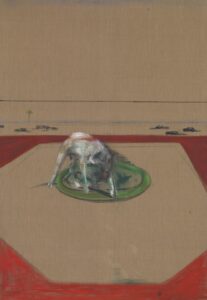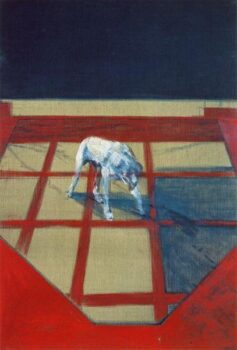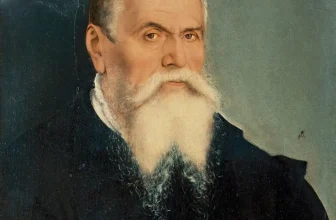Dog Painting Francis Bacon
Francis Bacon’s 1952 painting Dog is not merely an image of a lone animal in a sunlit wasteland, it is a chilling psychological portrait, a visual scream torn from the gut of post-war existential despair. This single figure, hunched and poised in a moment of tension, embodies the raw terror and uncertainty that underlies Bacon’s body of work. Like many of his paintings, Dog resists simple interpretation, yet it resonates with powerful symbolism, expressive technique, and unrelenting emotional gravity.
In this article, we’ll explore the origins of Dog (1952), the psychological and symbolic layers buried in its stark imagery, the artistic style Bacon employs, and where this haunting masterpiece resides today. We’ll trace its creation through the lens of Bacon’s turbulent life and dive into what this solitary dog might truly represent.
The Artist
To understand Dog, one must first understand Francis Bacon (1909–1992). Bacon was a British-Irish painter known for his raw, emotionally charged, and often grotesque imagery. His paintings frequently depict distorted human forms and animals, set in surreal, almost clinical environments. Deeply influenced by the atrocities of World War II, Bacon’s art became a vessel for expressing violence, vulnerability, mortality, and the darker recesses of the human psyche.
Bacon was self-taught and often worked from photographic references, including images from medical textbooks, crime scenes, and animal studies. He was particularly drawn to creatures in states of tension, violence, or isolation, dogs, bulls, baboons, animals stripped of domestication, reflecting the primal urges within all beings, including humans.
The Making of Dog (1952): When and How It Was Painted

Dog, 1952 painting by Francis Bacon
Dog was painted in 1952, during a particularly fertile and transitional period in Bacon’s career. The post-war years had pushed Bacon toward themes of isolation and existential dread. At the time, Bacon was producing works that often featured single figures, man or beast, contained in anonymous, often brutal environments. Dog emerged from this context, fusing the painter’s interests in animalistic expression and spatial ambiguity.
Bacon likely painted Dog in his London studio using oil on canvas. His technique was famously intuitive and impulsive. He would often paint directly onto the raw canvas without preparatory sketches. Using broad brushes, rags, and even his hands, Bacon manipulated the paint in ways that allowed chance and accident to inform the outcome. He welcomed distortions and often painted multiple versions of a work, destroying those that didn’t meet his merciless standards.
The subject in Dog appears drawn from photographs, possibly taken from a book on animal locomotion or behavior. Bacon admired the motion studies of Eadweard Muybridge, whose sequences of humans and animals in motion became a staple in Bacon’s visual library.
A Closer Look: What’s Happening in Dog (1952)
The painting presents a solitary dog crouched or lying on a flat, yellowish desert-like terrain. The animal is painted in a ghostly, almost insubstantial manner, rendered in browns and blacks that blend and blur with the shadow it casts. The dog appears to be in mid-snarl or bark, its head tilted, its teeth bared. There’s a sense of tension in the pose, as if the creature is caught in the moment before a sudden movement, either out of aggression or fear.
There’s no background to speak of. The setting is minimal, vast, and eerily quiet. A low horizon cuts across the canvas, separating the ochre ground from a pale, almost empty sky. There is no vegetation, no human presence, no shelter, only this solitary animal occupying a sun-bleached void.
But within that simplicity lies a world of tension. The dog is not just resting; it is alert. Is it about to attack? Is it protecting itself? Has it been abandoned? There are no clear answers, only questions, unease, and speculation. This ambiguity is essential to the painting’s power.
What Does Dog Represent, Symbolism and Meaning
At first glance, Dog seems to depict exactly what the title suggests, a lone animal. But Bacon’s dogs are never merely dogs. They are surrogates for human emotion, archetypes of instinct, vulnerability, and aggression. They embody the primal beneath the civilized.
1. Isolation and Alienation
The setting of Dog is stark and expansive, emphasizing the creature’s isolation. Bacon, often consumed by feelings of loneliness, projects that psychological state onto the canvas. The vast emptiness surrounding the dog becomes a metaphor for existential disconnection, a being adrift in an indifferent universe.
2. Animal Instinct and Human Nature
Bacon saw little separation between humans and animals. To him, both were driven by instinct, desire, and fear. In this sense, the dog becomes a mirror of human experience, crouched in defensiveness, snarling against threats both seen and unseen. The animal may symbolize repressed rage, trauma, or the basic will to survive.
3. The Shadow: Duality and Ghostliness
One of the most striking visual elements in Dog is the shadow that the animal casts. It is unusually large and dark, dominating much of the composition. The shadow almost threatens to consume the dog itself, suggesting a psychological or symbolic “double”, perhaps the dog’s inner fears, repressed instincts, or some lurking force just beneath the surface of consciousness.
This motif of the shadow might also be interpreted through a Jungian lens, as a representation of the “shadow self,” the darker, hidden aspects of one’s identity.
4. The Desert as Psychological Terrain
The barren landscape evokes not only a physical desert but a psychological one, a space of desolation, exposure, and spiritual emptiness. It’s a place stripped of comfort and familiarity, where only the most essential aspects of being remain. This mirrors the existential landscape that Bacon so often explored in his works.
What Kind of Art Is Dog (1952) Style and Technique
Dog is a quintessential example of post-war existential expressionism. Though Bacon rejected labels, critics have frequently associated his work with Expressionism, Surrealism, and even Figurative Abstraction. His art defies easy categorization because it bridges abstraction and representation, figures are recognizable but distorted beyond realism, revealing emotional and psychological truths.
Key Characteristics in Dog:
Figurative distortion: The dog is not anatomically accurate. It’s a composite of smeared lines and flesh-toned abstraction, suggestive rather than literal.
Atmospheric minimalism: The background is sparse but charged. The emptiness becomes an active component of the painting.
Emotive brushwork: Bacon’s strokes are urgent, unpolished, and raw. His method captures not form but feeling.
Shadow and space manipulation: The spatial dynamics are intentionally warped. The shadow does not conform to natural logic, but psychological logic.
Philosophical and Emotional Themes
Bacon was deeply influenced by existential thinkers such as Nietzsche and Sartre. These themes reverberate in Dog.
Mortality: The creature may be alive and snarling, but death seems to hover close, suggested by the stark shadow, the barren setting, the lack of context.
Survival: The painting captures a moment of tension, like a coiled spring. It’s the moment before fight or flight, survival in its most primal form.
Estrangement: There is no companion in this world, not human, not canine. The dog is utterly alone, echoing Bacon’s own sense of alienation.
Where Is Dog (1952) Located Today
As of the latest available information, Dog (1952) by Francis Bacon is held in the collection of the Stedelijk Museum voor Actuele Kunst (S.M.A.K.) in Ghent, Belgium. It is occasionally loaned to major retrospectives of Bacon’s work but typically resides in this prominent Belgian museum, which is dedicated to contemporary and modern art.
S.M.A.K. acquired the painting because of its critical importance within Bacon’s oeuvre and its reflection of the anxieties of the 20th century. When displayed, it often appears alongside other works dealing with themes of identity, trauma, and the human-animal boundary.
Why Dog Matters in Bacon’s Oeuvre
While Dog may not be as widely recognized as Bacon’s triptychs or papal portraits, it encapsulates many of the themes that define his work:
The breakdown between man and beast.
The fragility of life.
The ever-present threat of violence.
The isolation of modern existence.
It’s a quiet painting, compared to Bacon’s more gruesome compositions. But in its stillness lies an unspoken howl, a muted but powerful evocation of fear, vulnerability, and the instinctual core that connects us all.
Final Reflections: Dog as a Mirror
What makes Dog such a powerful work is its ambiguity. Is the creature snarling in aggression? Or whimpering in fear? Is it defending territory or reacting to an unseen threat? Bacon leaves these questions open, forcing viewers to confront their own projections.
In this way, Dog becomes more than a painting, it becomes a mirror. It asks the viewer: what are you seeing? A beast? A victim? Yourself?
That capacity for deep psychological engagement is the hallmark of Bacon’s genius. In Dog, he has captured a truth not about canines, but about being, alone, alert, and uncertain in an empty world.
TL;DR Summary
Title: Dog
Year: 1952
Artist: Francis Bacon
Medium: Oil on canvas
Style: Post-war expressionism, figurative abstraction
Symbolism: Isolation, primal instinct, existential fear, shadow self
Current Location: S.M.A.K. Museum, Ghent, Belgium
Themes: Alienation, mortality, animality, human condition
Why it matters: A haunting portrait of psychological and existential tension, distilled into a simple but profound image.
If you’re interested in visual philosophy, psychology in art, or post-war existentialism, Dog (1952) stands as a landmark painting, not just within Bacon’s career, but in 20th-century art itself. It howls not with volume, but with presence. image/wikiart/tate.org.uk




